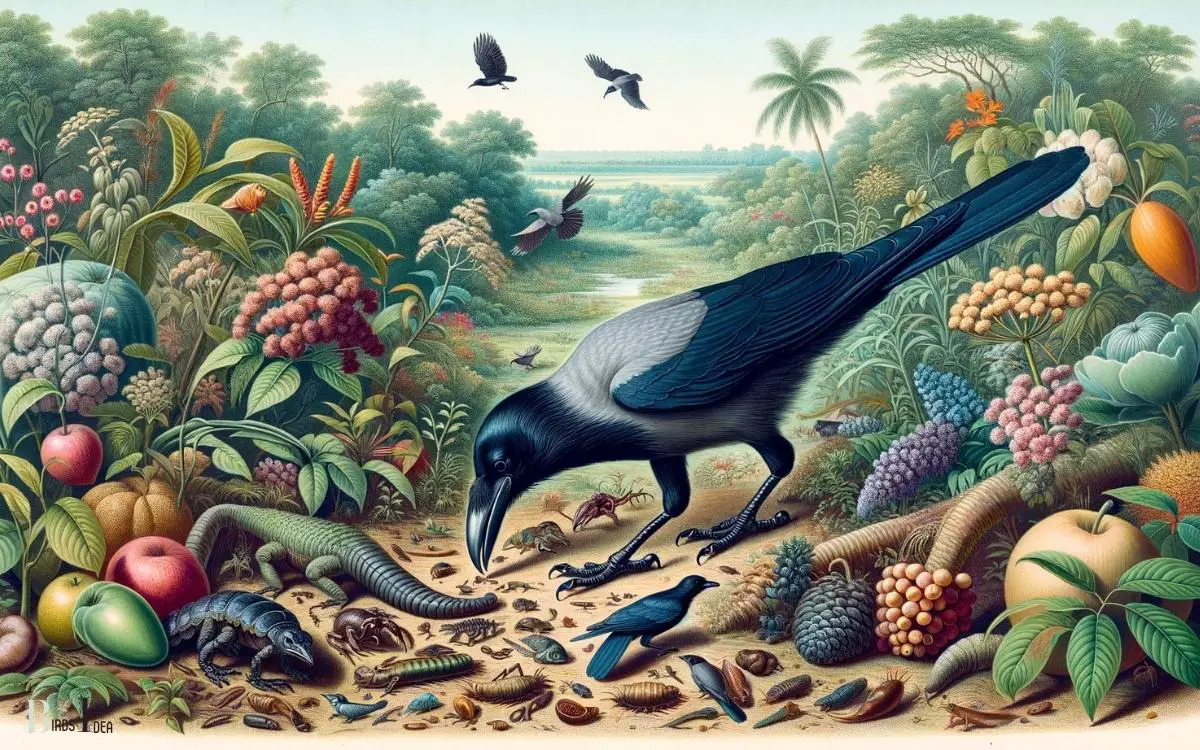What Does Indian Crow Eat? Insects, Fruits, Seeds!
The Indian crow primarily feeds on a variety of items including insects, fruits, seeds, grains, small animals, and carrion.
They are also known to eat garbage and waste from human habitats, making them highly adaptable to urban environments.
Indian crows have an omnivorous diet that can vary depending on the availability of food sources in their habitat.
Here are some of the common components of their diet:
- Insects: They consume various insects, which are a significant source of protein.
- Fruits: Seasonal fruits are eaten for their nutritional value.
- Seeds and Grains: These are a staple in their diet, especially in agricultural areas.
- Small Animals: They may eat rodents, small birds, and reptiles.
- Carrion: As scavengers, they feed on the carcasses of dead animals.
- Human Waste: They often scavenge in garbage dumps and urban areas for edible waste.
Adaptable and intelligent, the Indian crow’s dietary flexibility is a key to its survival in both rural and urban landscapes, making it a familiar sight across varied regions of the Indian subcontinent.

Key Takeaway
Insectivorous Diet
The Indian crow primarily feeds on insects as a crucial component of its dietary habits. These highly adaptable birds are known for their insectivorous nature, preying on a wide range of insects including beetles, caterpillars, grasshoppers, and spiders.
Their foraging behavior is characterized by keen observational skills and agile movements, allowing them to capture prey with precision.
Indian crows are often seen scavenging for insects in diverse habitats such as urban areas, agricultural fields, and open woodlands.
Their ability to consume a variety of insects makes them important contributors to pest control, especially in agricultural landscapes.
This insect-rich diet not only sustains the Indian crow population but also plays a significant role in regulating insect populations in the ecosystems they inhabit.
Carnivorous Tendencies
With a penchant for scavenging and hunting, Indian crows exhibit carnivorous tendencies as they expand their diet to include small vertebrates and carrion.
While their primary diet consists of insects and grains, they are known to opportunistically prey on small mammals, reptiles, amphibians, and even other birds.
This behavior often occurs in urban areas where they scavenge for food scraps and small prey.
Their keen intelligence and adaptability enable them to exploit a wide range of food sources, including roadkill and discarded human food.
The Indian crow’s sharp beak and agile nature equip it to capture and consume a variety of small vertebrates, making it an efficient carnivorous forager.
This carnivorous behavior reflects the crow’s ability to adapt its diet to the available resources, showcasing its resilience and opportunistic nature in the wild.
Omnivorous Appetite
Exhibiting an omnivorous appetite, Indian crows consume a diverse range of food items, including fruits, vegetables, and human leftovers.
Their ability to adapt to various environments allows them to scavenge for food in urban, suburban, and rural areas.
The omnivorous nature of Indian crows is evident in their feeding habits, as they are known to consume:
- Fruits: Crows are often observed feeding on a variety of fruits, such as berries, mangoes, and figs.
- Vegetables: They have been documented consuming vegetables like peas, corn, and even small roots and tubers.
- Human Leftovers: Their scavenging behavior leads them to feed on human leftovers, including bread, rice, and other food scraps.
- Insects and Small Animals: In addition to plant-based foods, Indian crows also feed on insects, small rodents, and amphibians, showcasing their diverse dietary preferences.
Fruit and Grain Consumption
Indian crows consume a variety of fruits and grains as part of their diverse diet. They are known to feed on a wide range of fruits such as figs, berries, and mangoes.
Crows have been observed foraging for grains including rice, wheat, and corn in agricultural fields and open areas.
The consumption of fruits and grains complements their omnivorous nature, providing essential carbohydrates, vitamins, and minerals.
This dietary flexibility allows Indian crows to adapt to different habitats and food sources, contributing to their widespread distribution across urban, suburban, and rural environments.
Their ability to thrive on fruits and grains highlights their opportunistic feeding behavior and their capacity to utilize diverse food resources, making them highly adaptable and successful avian scavengers.
Scavenging and Human Food Preferences
Scavenging for food, Indian crows exhibit a preference for human food items, including leftovers and discarded meals.
This behavior has been observed in urban and suburban areas where human populations are dense.
The crows have shown a remarkable ability to adapt to human environments and capitalize on the availability of human food sources.
Their preference for human food items is evident from their foraging behavior, as they actively seek out the following items:
- Leftover fast food such as fries, burgers, and pizza.
- Unattended food at outdoor events or picnics.
- Discarded food in garbage bins or dumpsters.
- Food scraps near food stalls and eateries.
This scavenging behavior highlights the crow’s opportunistic nature and their ability to exploit human activities for sustenance.
Conclusion
The Indian crow’s diet consists of a diverse range of food sources. These include insects, small animals, fruits, grains, and human food.
Their omnivorous nature and scavenging tendencies allow them to adapt and thrive in various environments.
Their ability to consume a wide variety of foods showcases their resourcefulness and adaptability. This makes them an intriguing and essential part of the ecosystem.






